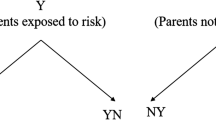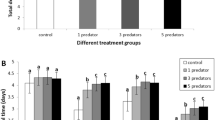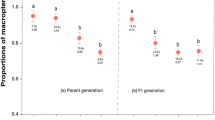Abstract
Predators can significantly impact potential prey without consuming them, generating potential ramifications for biological control. In this study, we examined the cumulative impacts of adult Harmonia axyridis Pallas (Coleoptera: Coccinellidae) on development and reproduction of Helicoverpa armigera Hübner (Lepidoptera: Noctuidae), over three generations. Development became faster in each of the three generations and pupae became heavier than controls, although survival declined in the third generation. Predator stress increased wing deformations in the first generation, but not thereafter, and female fecundity became higher than controls in the third generation. We concluded that predator stress increased larval consumption to eventually result in both faster development and larger adult size when food was abundant. The results demonstrated that H. armigera could respond to exposure from a non-consumptive predator by shifting aspects of developmental timing and increasing reproductive effort, with both individual- and population-level consequences. The adaptive significances of these changes are discussed. This study advances our understanding of the potential for non-lethal predators to impact prey life histories.




Similar content being viewed by others
References
Ball SL, Baker RL (1996) Predator-induced life history changes: antipredator behavior costs or facultative life history shifts? Ecology 77:1116–1124
Beckerman AP, Wieski K, Baird DJ (2007) Behavioural versus physiological mediation of life history under predation risk. Oecologia 152:335–343
Benard MF (2004) Predator-induced phenotypic plasticity in organisms with complex life histories. Annu Rev Ecol Evol Syst 35:651–673
Benard MF, Fordyce JA (2003) Are induced defenses costly? Consequences of predator-induced defenses in western toads, Bufo boreas. Ecology 84:68–78
Brodin T, Johansson F (2002) Effects of predator-induced thinning and activity changes on life history in a damselfly. Oecologia 132:316–322
Brodin T, Mikolajewski DJ, Johansson F (2006) Behavioural and life history effects of predator diet cues during ontogeny in damselfly larvae. Oecologia 148:162–169
Evans EW (2009) Lady beetles as predators of insects other than Hemiptera. Biol Control 51:255–267
Fox CW, Czesak ME (2000) Evolutionary ecology of progeny size in arthropods. Annu Rev Entomol 45:341–369
Hammill E, Rogers A, Beckerman AP (2008) Costs, benefits and the evolution of inducible defences: a case study with Daphnia pulex. J Evol Biol 21:705–715
Hawlena D, Schmitz OJ (2010a) Physiological stress as a fundamental mechanism linking predation to ecosystem functioning. Am Nat 176:537–556
Hawlena D, Schmitz OJ (2010b) Herbivore physiological response to predation risk and implications for ecosystem nutrient dynamics. Proc Natl Acad Sci USA 107:15503–15507
Hechtel LJ, Juliano SA (1997) Effects of a predator on prey metamorphosis: plastic responses of prey or selective mortality? Ecology 78:838–851
Huhta A, Muotka T, Tikkanen P (2000) Nocturnal drift of mayfly nymphs as a post-contact antipredator mechanism. Freshw Biol 45:33–42
Kimbro DL (2012) Tidal regime dictates the cascading consumptive and nonconsumptive effects of multiple predators on a marsh plant. Ecology 93:334–344
Koch RL (2003) The multicolored Asian lady beetle, Harmonia axyridis: a review of its biology, uses in biological control, and non-target impacts. J Insect Sci 3:32
Kunert G, Otto S, Roese USR, Gershenzon J, Weisser WW (2005) Alarm pheromone mediates production of winged dispersal morphs in aphids. Ecol Lett 8:596–603
Li YP, Ge F (2010) Effect of prey stress from Propy lea japonica on development and fecundity of Drosophila melanogaster in successive three generations. Chin Bull Entomol 47:139–145
Mangel M, Stamps J (2001) Trade-offs between growth and mortality and the maintenance of individual variation in growth. Evol Ecol Res 3:583–593
Matassa CM, Trussell GC (2011) Landscape of fear influences the relative importance of consumptive and nonconsumptive predator effects. Ecology 92:2258–2266
McCauley SJ, Davis CJ, Werner EE (2008) Predator induction of spine length in larval Leucorrhinia intacta (Odonata). Evol Ecol Res 10:435–447
McCauley SJ, Rowe L, Fortin MJ (2011) The deadly effects of “nonlethal” predators. Ecology 92:2043–2048
McCollum SA, Buskirk JV (1996) Costs and benefits of a predator-induced polyphenism in the gray treefrog Hyla chrysoscelis. Evolution 50:583–593
McPeek MA (2004) The growth/predation risk trade-off: so what is the mechanism? Am Nat 163:E88–E111
McPeek MA, Grace M, Richardson JML (2001) Physiological and behavioral responses to predators shape the growth/predation risk trade-off in damselflies. Ecology 82:1535–1545
Michaud JP, Olsen LE (2004) Suitability of Asian citrus psyllid, Diaphorina citri, as prey for ladybeetles. BioControl 49:417–431
Nelson EH, Matthews CE, Rosenheim JA (2004) Predators reduce prey population growth by inducing changes in prey behaviour. Ecology 85:1853–1858
Orizaola G, Dahl E, Laurila A (2012) Reversibility of predator-induced plasticity and its effect at a life-history switch point. Oikos 121:44–52
Pangle KL, Peacor SD, Johannsson OE (2007) Large nonlethal effects of an invasive invertebrate predator on zooplankton population growth rate. Ecology 88:402–412
Peacor SD (2002) Positive effect of predators on prey growth rate through induced modifications of prey behaviour. Ecol Lett 5:77–85
Peacor SD, Werner EE (1997) Trait-mediated indirect interactions in a simple aquatic food web. Ecology 78:1146–1156
Peacor SD, Peckarsky BL, Trussell GC, Vonesh JR (2013) Costs of predator-induced phenotypic plasticity: a graphical model for predicting the contribution of nonconsumptive and consumptive effects of predators on prey. Oecologia 171:1–10
Peckarsky BL, Taylor BW, McIntosh AR, McPeek MA, Lytle DA (2001) Variation in mayfly size at metamorphosis as a developmental response to risk of predation. Ecology 82:740–757
Peckarsky BL, Abrams PA, Bolnick DI, Dill LM, Grabowski JH, Luttbeg B, Orrock JL, Peacor SD, Preisser EL, Schmitz OJ, Trussell GC (2008) Revisiting the classics: considering non-consumptive effects in textbook examples of predator–prey interactions. Ecology 89:2416–2425
Pimentel C, Santos M, Ferreira C, Nilsson JA (2012) Temperature, size, reproductive allocation, and life-history evolution in a gregarious caterpillar. Biol J Linn Soc 105:340–349
Preisser EL, Bolnick DI (2008) The many faces of fear: comparing the pathways and impacts of nonconsumptive predator effects on prey populations. PLoS ONE 3:e2465
Preisser EL, Bolnick DI, Benard MF (2005) Scared to death? The effects of intimidation and consumption in predator–prey interactions. Ecology 86:501–509
Qian SS (2009) Environmental and Ecological Statistics with R. CRC Press, Florida
R Foundation for Statistical Computing (2015) A language and environment for statistical computing. R Foundation for Statistical Computing, Vienna
Relyea RA (2003) Predators come and go: the reversibility of predator-induced traits. Ecology 84:1840–1848
Roff DA (2001) Age and size at maturity. In: Fox CW, Roff DA, Fairbairn DJ (eds) Evolutionary ecology, concepts and case studies. Oxford University Press, New York, pp 99–112
Sheriff MJ, Krebs CJ, Boonstra R (2009) The sensitive hare: sublethal effects of predator stress on reproduction in snowshoe hares. J Anim Ecol 78:1249–1258
Slos S, Stoks R (2008) Predation risk induces stress proteins and reduces antioxidant defense. Funct Ecol 22:637–642
Slos S, De Meester L, Stoks R (2009) Food level and sex shape predator-induced physiological stress: immune defence and antioxidant defence. Oecologia 161:461–467
SPSS (1998) SPSS 8.0 for windows. SPSS Inc., Prentice Hall, New Jersey
Stoks R (2001) Food stress and predator-induced stress shape developmental performance in a damselfly. Oecologia 127:222–229
Stoks R, De Block M, McPeek MA (2005) Alternative growth and energy storage responses to mortality threats in damselflies. Ecol Lett 8:1307–1316
Tay WT, Soria MF, Walsh T, Thomazoni D, Silvie P, Behere GT, Anderson C, Downes S (2013) A brave new world for an old world pest: Helicoverpa armigera (Lepidoptera: Noctuidae) in Brazil. PLoS ONE 8:e80134
van Uitregt VO, Hurst TP, Wilson RS (2012) Reduced size and starvation resistance in adult mosquitoes, Aedes notoscriptus, exposed to predation cues as larvae. J Anim Ecol 81:108–115
Vonesh JR, Warkentin KM (2006) Opposite shifts in size at metamorphosis in response to larval and metamorph predators. Ecology 87:556–562
Walzer A, Schausberger P (2009) Non-consumptive effects of predatory mites on thrips and its host plant. Oikos 118:934–940
Walzer A, Lepp N, Schausberger P (2015) Compensatory growth following transient intraguild predation risk in predatory mites. Oikos 124:603–609
Weber DC, Lundgren JG (2009) Assessing the trophic ecology of the Coccinellidae: their roles as predators and as prey. Biol Control 51:199–214
Werner EE, Peacor SD (2003) A review of trait-mediated indirect interactions in ecological communities. Ecology 84:1083–1100
Wu KJ (1980) The artificial diet of Helicoverpa armigera Hübner (Lepidoptera: Noctuidae). Chin Bull Entomol 17:36–37
Wu KM, Mu W, Liang GM, Guo YY (2005) Regional reversion of insecticide resistance in Helicoverpa armigera (Lepidoptera: Noctuidae) is associated with the use of Bt cotton in northern China. Pest Manag Sci 61:491–498
Yarro JG (1985) Effect of host plant on moulting in the African armyworm, Spodoptera exempta (Walker) (Lepidoptera: Noctuidae) at constant temperature and humidity conditions. Insect Sci Appl 6:171–175
Acknowledgments
This research was funded by the National “Twelfth Five-Year” Plan for Science & Technology Support of China (2012BAD19B05). The authors thank the Beijing Academy of Agricultural and Forestry Sciences for allowing the collection of lady beetles in their experimental fields, Fan Zhang for technical assistance with predator rearing, and Qingpo Yang for help with data collection.
Author information
Authors and Affiliations
Corresponding author
Additional information
Handling Editor: Marta Montserrat.
Rights and permissions
About this article
Cite this article
Xiong, X., Michaud, J.P., Li, Z. et al. Chronic, predator-induced stress alters development and reproductive performance of the cotton bollworm, Helicoverpa armigera . BioControl 60, 827–837 (2015). https://doi.org/10.1007/s10526-015-9689-9
Received:
Accepted:
Published:
Issue Date:
DOI: https://doi.org/10.1007/s10526-015-9689-9




